 Founded in 1926.in the city of Turin, Italy by amateur race-car driver, Giorgio Ambrosini, SIATA (Society Italiana Applicazioni Trasformazioni Automobilistiche) , Italy was already intended to be sollely a machine shop.
Founded in 1926.in the city of Turin, Italy by amateur race-car driver, Giorgio Ambrosini, SIATA (Society Italiana Applicazioni Trasformazioni Automobilistiche) , Italy was already intended to be sollely a machine shop.
In the years leading up to the outbreak of the Second World War. Ambrosini concentrated Siata’s activities on the development of and performance/tuning tools and latterly engine and gearbox tuning and modification for most of the leading Italian car manufacturers, although for Fiat in particular.
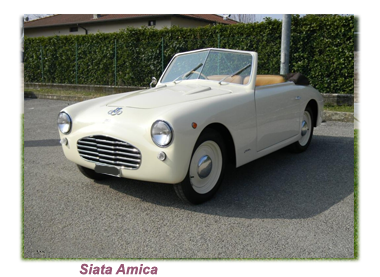 The depth of Siata cooperation in the pre-war years reached its peak in 1936 with the launch of the Fiat 500 Topolino in 1936., with Ambrosini being asked to develop a cabriolet variant standing out with its trademark vee-shaped grille.
The depth of Siata cooperation in the pre-war years reached its peak in 1936 with the launch of the Fiat 500 Topolino in 1936., with Ambrosini being asked to develop a cabriolet variant standing out with its trademark vee-shaped grille.
As Europe descended into World War Two, all domestic car production was pit on hold, and for a while it appeared unlikely that Siata would ever get back into production, in any format.
However Ambrosini was not to be deterred, and in 1948 the company he had founded released its first production model- the Amica.
Quirky and spartan in appearance the Amica was powered by a rear-mounted aluminium 750cc four-cylinder engine with dual overhead cams, capable of generating 25bhp.
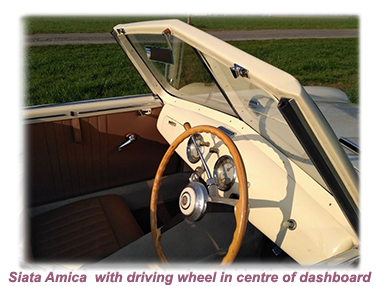 Set up with three seats, with the driver unusually occupying the centre position, the Amica was available as a two-seat spider (convertible) as well as in coupe form. Needless to say, the soft top was the far more popular version with three hundred Siata Amica soft tops produced and about forty hard top versions were made.
Set up with three seats, with the driver unusually occupying the centre position, the Amica was available as a two-seat spider (convertible) as well as in coupe form. Needless to say, the soft top was the far more popular version with three hundred Siata Amica soft tops produced and about forty hard top versions were made.
Because of the scarcity the Siata Amica, especially the hard top model, was somewhat rare and in increasing demand in the car collector’s world.
Siata and their Amica found themselves rapidly on the map when one of the original prototypes a unique racing edition of the Amica featuring a five-speed gearbox and 42-bhp engine took first place in its category in the Italian championship in 1948.
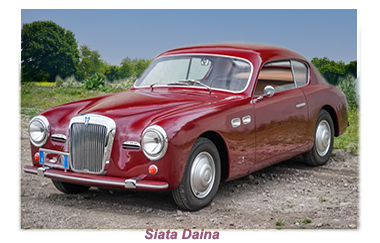 The next model to emerge from the Siata stable was the Daina, based around Fiat's 1400 with its engine tuned to top 90 mph. Designed with both open and closed bodies, the Daina remained in production well into the late Nineteen Fifties and was undoubtedly Siata’s best seller with just under two hundred units during its almost ten year production run .
The next model to emerge from the Siata stable was the Daina, based around Fiat's 1400 with its engine tuned to top 90 mph. Designed with both open and closed bodies, the Daina remained in production well into the late Nineteen Fifties and was undoubtedly Siata’s best seller with just under two hundred units during its almost ten year production run .
 To coincide with the launch of of Fiat’s V8 engine in 1952, the first Siata chassis was released. . Built of tubular sections, the new chassis was brand fresh, with most of the running gear coming from Fiat components bin. The suspension using unequal length arms was independent all around. Big aluminium drum brakes supplied the stopping force.
To coincide with the launch of of Fiat’s V8 engine in 1952, the first Siata chassis was released. . Built of tubular sections, the new chassis was brand fresh, with most of the running gear coming from Fiat components bin. The suspension using unequal length arms was independent all around. Big aluminium drum brakes supplied the stopping force.
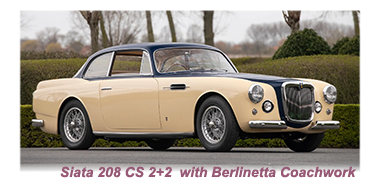 The new Siata, the 208, ran Fiat's quite odd 70-degree V8 engine. With Siata's faster camshaft and triple Weber Carburetors, the output could be raised to 140 bhp. Stock trim the two litre OHV engine generated slightly over 100 horsepower.
The new Siata, the 208, ran Fiat's quite odd 70-degree V8 engine. With Siata's faster camshaft and triple Weber Carburetors, the output could be raised to 140 bhp. Stock trim the two litre OHV engine generated slightly over 100 horsepower.
 Reaction to the Siata 208 launched in early 1952 was mixed. Critical appraiser for design and handling was high, the vehicle’s exorbitant price tag placed it out well out of the range of the niche buyer looking for a lower priced Ferrari or Maserati alternative, with MGs, Jaguars, or Porsches taking most of that market share in the US.
Reaction to the Siata 208 launched in early 1952 was mixed. Critical appraiser for design and handling was high, the vehicle’s exorbitant price tag placed it out well out of the range of the niche buyer looking for a lower priced Ferrari or Maserati alternative, with MGs, Jaguars, or Porsches taking most of that market share in the US.
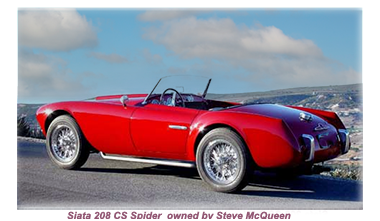 Ernie McAfee, at that time a well-known California based car dealer and renowned road racer, with considerable connections in the film industry in Hollywood began to market 208s.
Ernie McAfee, at that time a well-known California based car dealer and renowned road racer, with considerable connections in the film industry in Hollywood began to market 208s.
A considerable feather in McAfee’s cap was succeeding in convincing action hero and enthousiastic road racer Steve MacQueen to add a Siata 208 to his collection.
A fact that brought a lot of attention but very few other buyers.
Realising that his niche lay in the spider style compact, Giorgio Ambrosini, over the remaining years that they were in production, insisted that Siata specialise in developing sports versions of Fiat’s standard models.
Possibly the most successful Siata, at least in terms of eye -was the Spring, launched in 1968, based on Fiat 850, which provided a classic look and pleasant driving experience even though it enjoyed only a little success on the European market.
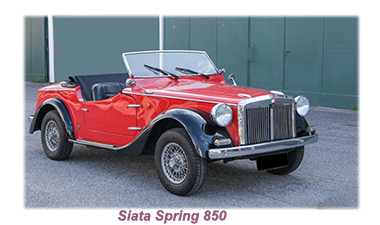 On the other hand, in the US, demand for the spring was surprisingly high with Ernie McAfee taking orders for hundreds of Springs. Unfortunately, Siata did not have anything approaching the production facilities to meet the demand, causing Ambrosini, to make the painful and surprising decision in 1970 to wind down his vehicle production facility to concentrate on producing spare parts mostly for Fiat.
On the other hand, in the US, demand for the spring was surprisingly high with Ernie McAfee taking orders for hundreds of Springs. Unfortunately, Siata did not have anything approaching the production facilities to meet the demand, causing Ambrosini, to make the painful and surprising decision in 1970 to wind down his vehicle production facility to concentrate on producing spare parts mostly for Fiat.
Siata stayed in existence for a few more years but never reclaimed its former popularity.
Although exact statistics are not available from the late Forties, when Siata started producing its own cars, and their withdrawal from production in 1970, the company manufactured about 1,850 cars.
History has it that the one major jewel in their crown was the Ferrari red Siata 208 that Steve MacQueen was proud to won and drive through most of the Fifties.


